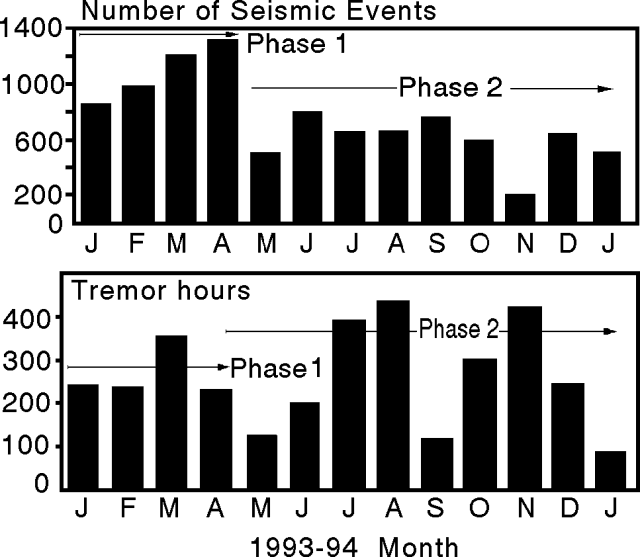Report on Arenal (Costa Rica) — January 1994
Bulletin of the Global Volcanism Network, vol. 19, no. 1 (January 1994)
Managing Editor: Richard Wunderman.
Arenal (Costa Rica) Lava flows continue; summary of 1993 behavior
Please cite this report as:
Global Volcanism Program, 1994. Report on Arenal (Costa Rica) (Wunderman, R., ed.). Bulletin of the Global Volcanism Network, 19:1. Smithsonian Institution. https://doi.org/10.5479/si.GVP.BGVN199401-345033
Arenal
Costa Rica
10.463°N, 84.703°W; summit elev. 1670 m
All times are local (unless otherwise noted)
Relatively quiet conditions prevailed at Arenal in December 1993 and most of January 1994. Starting on 28 January, both Strombolian activity and pyroclastic output increased. These outbursts were noted in La Palma, a village 4 km N of Crater C, where explosions vibrated the glass windows of houses.
Arenal continued its ongoing emission of gases and lava from its active vent, Crater C, situated just W of the summit. Some basic observations were made in the interval January 1993 through January 1994. Crater C emitted lava that flowed toward the S, SW, W, and NW. Strombolian eruptions produced columns that reached as high as several kilometers above the crater. Ash chiefly fell toward the NW, W, and SW, and noticeable amounts fell as far away as 25 km WNW (Tronadora), and 28 km W (Tilarán). Pyroclastic flows mainly traveled towards the NW, W, SW, S, and SE. The most noteworthy pyroclastic flow of the interval took place on 28 August; the same eruption also produced an accretionary lapilli fall deposit.
Figure 67 shows seismicity and tremor at Arenal for January 1993 through January 1994. The OVSICORI seismic station functioned for 19 days in January. During this time it registered an average of 15.8 earthquakes/day. Assuming the 19 days suitably reflect the average seismicity for the whole month, the estimated number of January events is 491 (figure 67). This estimate is in rough accord with an unbroken record of January seismicity at the ICE station ("La Fortuna," located 3.5 km E of Crater C). A similar averaging and readjustment procedure was also applied for tremor, and again this is in rough accord with the record seen at the ICE station.
The seismicity for January 1993 through January 1994 was divided into two phases. The interval January-April 1993, termed Phase 1, had the most explosive behavior. Phase 1 was characterized as follows: a) seismicity typically in the range of 27-44 events/day, b) seismic signals predominantly in the high-to-moderate frequency range, c) high sound levels, and d) explosions, sometimes accompanied by pyroclastic flows.
The interval May 1993-January 1994 was termed Phase 2. It was characterized as follows: a) an average of 7-26 seismic events/day, b) seismic signals of low-frequency, short duration, and low amplitude, and c) intermediate sound levels described as like those of a jet or locomotive. Phase 2 also had relatively low numbers of seismic events and the most pronounced highs in tremor duration, the latter associated with lava emission.
Scientists at OVSICORI described the eruptive behavior of Arenal based on the following model of the magma conduit. Phase 1 behavior, when major explosions took place, resulted from a more restricted conduit. Phase 2 behavior, characterized by jet and locomotive sounds, high tremor, and common lava emissions, resulted from a less restricted conduit.
Geological Summary. Conical Volcán Arenal is the youngest stratovolcano in Costa Rica and one of its most active. The 1670-m-high andesitic volcano towers above the eastern shores of Lake Arenal, which has been enlarged by a hydroelectric project. Arenal lies along a volcanic chain that has migrated to the NW from the late-Pleistocene Los Perdidos lava domes through the Pleistocene-to-Holocene Chato volcano, which contains a 500-m-wide, lake-filled summit crater. The earliest known eruptions of Arenal took place about 7000 years ago, and it was active concurrently with Cerro Chato until the activity of Chato ended about 3500 years ago. Growth of Arenal has been characterized by periodic major explosive eruptions at several-hundred-year intervals and periods of lava effusion that armor the cone. An eruptive period that began with a major explosive eruption in 1968 ended in December 2010; continuous explosive activity accompanied by slow lava effusion and the occasional emission of pyroclastic flows characterized the eruption from vents at the summit and on the upper western flank.
Information Contacts: E. Fernández, J. Barquero, R. Van der Laat, F. de Obaldia, T. Marino, V. Barboza, and R. Sáenz, OVSICORI; G. Soto, G. Alvarado, and F. Arias, ICE; H. Flores, Univ de Costa Rica.


